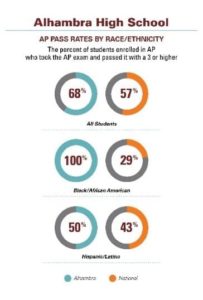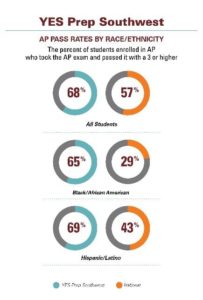Systems for Success: Thinking Beyond Access to AP
Ed Trust Case Studies Show How Schools Can Achieve the Dual Goals of AP Access and Success for Underserved Students
WASHINGTON (July 26, 2017) – As schools and districts respond to appeals to expand access for students traditionally shut out of college-level courses such as Advanced Placement (AP), The Education Trust calls for school leaders to be deliberate about ensuring that their students have the best possible chance for success.
To support this, The Education Trust today released a brief, “Systems for Success: Thinking Beyond Access to AP,” which explores the practices of two diverse high schools that have achieved the dual goals of enrolling more students of color and low-income students in AP courses and increasing the percentage of students passing the associated exams.
The national data are clear: More students of color are taking AP exams, but success rates for these students lag behind those of their peers. Between 2004 and 2013, Black and Latino students increased the number of AP tests they took. Black students went from being 6 percent of the test-takers to 9 percent; Latino students from 13 to 19 percent. Yet, while 57 percent of AP test-takers overall scored a 3 or above in 2013, just 30 percent of Black AP test-takers and 42 percent of Latino test-takers scored at that level. A passing score of 3 qualifies for course credit in many colleges.
With many ongoing efforts to expand AP, including an increased focus on AP in many states’ plans to implement the Every Student Succeeds Act, or ESSA, it’s critical that school leaders learn from their peers who are expanding success as well as access.
“While it is encouraging that school leaders are opening the doors to AP courses for more students of color, large gaps in success rates remain,” said Ashley Griffin, Ph.D., interim director of P-12 research at The Education Trust. “Our case studies show what it takes to get underserved students not just into AP, but to realize the benefits of successful AP performance.”
Systems for Success showcases the following two schools:
 Alhambra High School, Alhambra, CA
Alhambra High School, Alhambra, CA
Alhambra High School is a neighborhood high school in Los Angeles County that serves 2,512 students — half of the students are Latino (51 percent) and nearly three-fourths (72 percent) qualify for free-or reduced-priced lunch. Alhambra’s AP access rate — the percentage of students taking at least one AP exam — is 35 percent, which is 10 percentage points greater than the national average. And its success rate — the percentage of test-takers who pass an exam — is 68 percent, which is 1.2 times the national average.
Alhambra boasts a school culture that promotes successful AP experiences for both students and teachers. According to Principal Duane Russell, “AP is rigorous for the teachers, just like it is for the kids.” This prompted Russell to create systematic support for teachers, including mentor teachers, attendance to AP Summer Institute by the College Board, and a master schedule to manage all the additional classes, student requests, tutoring, and teachers’ schedules. This system ensured that the school’s programs for the AP students and teachers didn’t conflict with each other, making it easier to attend and participate.
 YES Prep Southwest, Houston TX
YES Prep Southwest, Houston TX
YES Prep Southwest, in Houston, Texas, serves 926 students — the majority of whom are Latino (89.5 percent) and nearly 9 in 10 of whom (87 percent) qualify for free-or reduced-priced lunch. The school’s access rate for AP is 40 percent, which is 15 percentage points greater than the national average. And its success rate is 68 percent, which, like Alhambra High is 1.2 times the national average.
Leaders at YES Prep Southwest align their curriculum, beginning in the sixth grade to progressively incorporate more rigor and critical thinking, thus preparing students for AP courses later in high school. The school also helps teachers through regular collaborative workshops with other AP teachers in the YES Prep network so they can share resources, plan assignments, and take advantage of peer support.
Alhambra and YES Prep provide clear examples of types of actions school leaders need to take to not only give their students access to AP classes, but also a good chance of success:
- Ensure that master schedules provide students sufficient opportunities to take classes and attend any additional help and tutoring offered by the school.
- Ensure that AP teachers are sufficiently prepared to teach the classes and have any additional support they need.
- Ensure that the courses students take in the years before they take AP classes provide them with the pre-requisite levels of knowledge, skill, and rigor (i.e., vertically align their curriculum).
- Ensure that AP faculty and school leaders regularly examine their data to find areas of strength that need to be celebrated and areas of weakness that need to be addressed.
- Try other, less conventional, ideas that might help students, such as bringing in tutors from local colleges, and evaluate their effect.
“The inspired leaders highlighted in this brief have two things in common. First, they see past the outdated assumptions that students of color are less capable of AP level work than their White peers. Second, when they create opportunities for their students to enroll in AP classes, they also create schoolwide support programs that enable both the teachers and the students to successfully transition to the rigors of AP coursework,” said Griffin.











